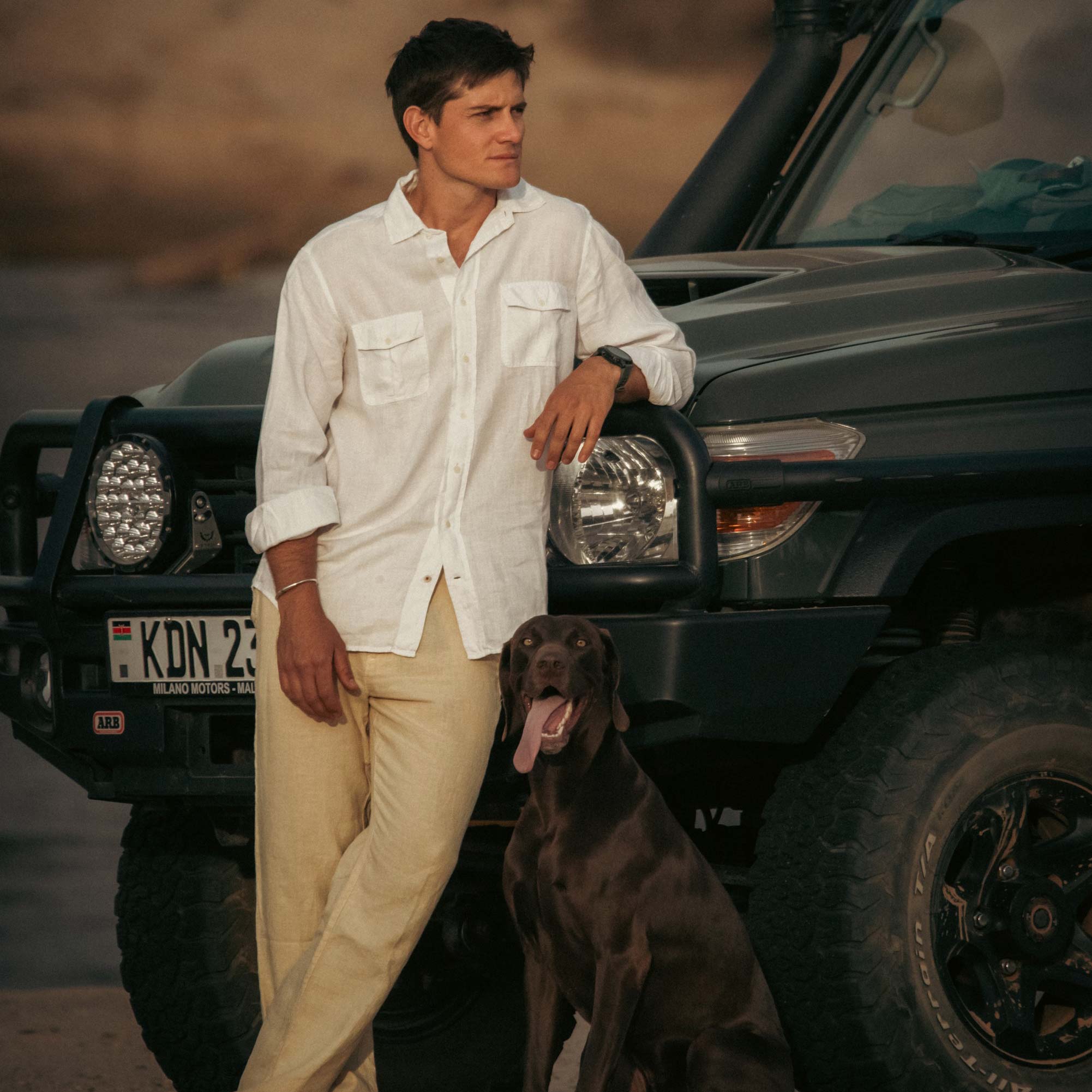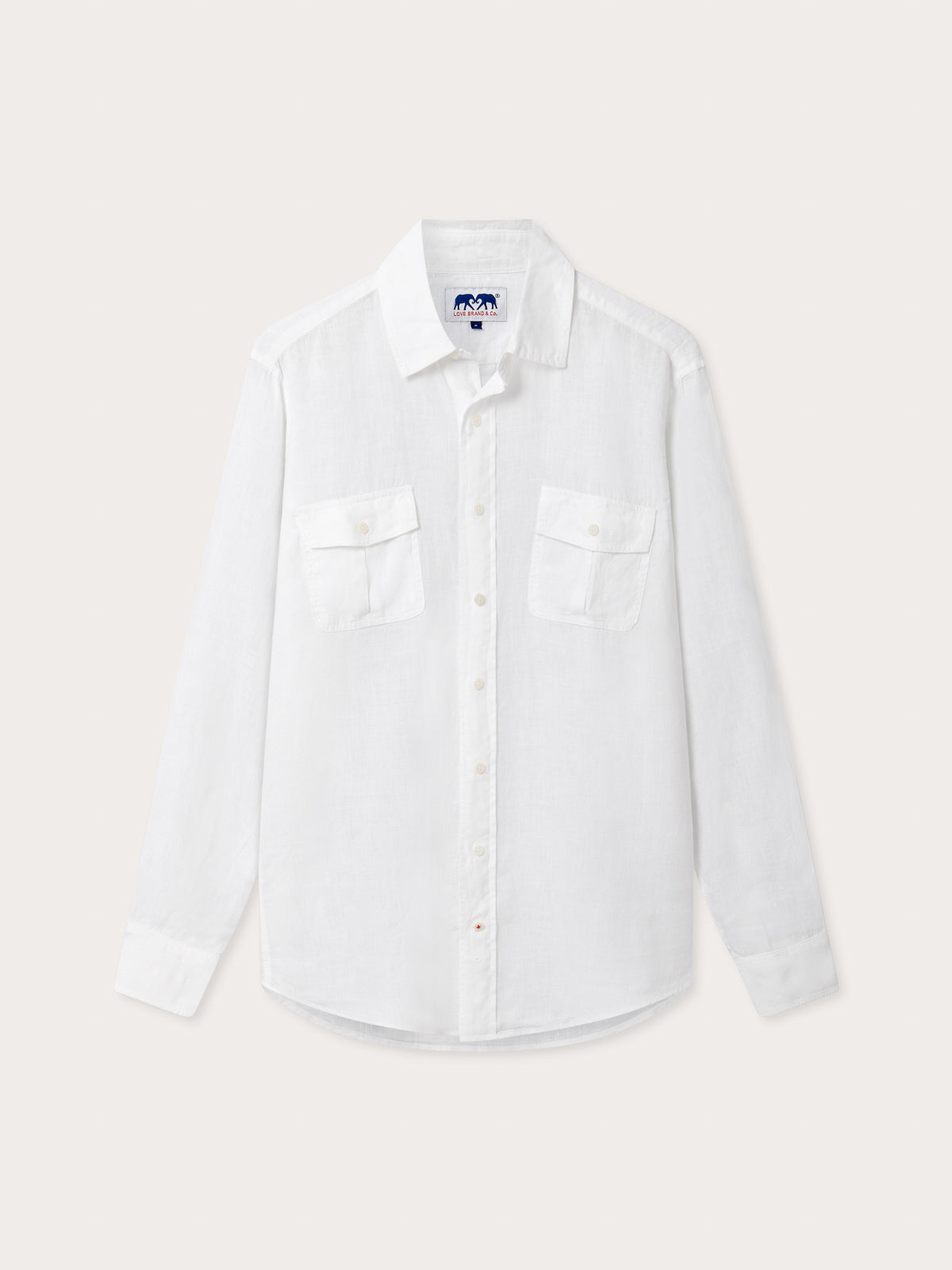Protecting Paradise Chapter 1: Meet Conservation Heroes Roan and Taru Carr-Hartley
We sat down with pilot brothers Taru and Roan Carr-Hartley to discuss their incredible conservation work and Sheldrick Wildlife Trust’s fight for Kenya’s wildlife.
We sat down with pilot brothers Taru and Roan Carr-Hartley to discuss their incredible conservation work and Sheldrick Wildlife Trust’s fight for Kenya’s wildlife.
Above: Roan Carr-Hartley in his plane for Sheldrick Wildlife Trust wearing LOVE BRAND & Co. Men's Olive Andros Shirt & Men's Stone Burrow Linen Shorts.
LOVE BRAND & Co. has proudly supported the Sheldrick Wildlife Trust for over a decade. This incredible charity, dedicated to continuing the legacy of Dr. Dame Daphne Sheldrick DBE, is a beacon of hope for Kenya’s wildlife. From rescuing orphaned elephants to protecting Kenya’s diverse wildlife, the Trust’s work is nothing short of heroic. At the heart of the action are Daphne’s grandsons, Taru and Roan, who spend their days on daily daring adventures, tackling poaching and aiding animals in need. We sat down with the brothers to hear their incredible stories and learn more about their vital work.





Taru Carr-Hartley: Every day is different. Most of the time we'll start with a flight in the morning. Me, personally, I’ll be in the helicopter - this could be a routine anti-poaching patrol with rangers to check out an area, or something that's been prior organised such as an elephant treatment mission. Then after that, it depends on how it goes and if there are findings in the day. Let's say on our flight in the morning we find poachers' track, we’ll then spend the rest of the day out looking for poachers. Otherwise, I'll get back to base and be on standby for human-wildlife conflict callouts, medical evacuations, treatments, and translocations. At the same time, we’ll be in the command centre at various points throughout the day helping manage and monitor the anti-poaching efforts.
When we go out we’re on the look out for all manner of activities. It's not only elephant or bushmeat poaching. Using the chopper, we take a team of rangers on board – often with one of our trained tracker dogs - and we'll go to areas that we know are hotspots. The helicopter allows us access places that are incredibly hard to access on the ground, by vehicle or on foot. Landing at these locations we can identify any signs of footprints or illegal activities. That might be the illegal harvesting of wood, illegal mining, cattle grazing, and of course any evidence of poaching. There are so many different things and what you find will vary across the vast area we patrol.

Roan: It was a very unique childhood and we were blessed to grow up surrounded by animals and nature our whole lives, which I think a lot of our friends were quite envious of. Every day they would go home to their city homes and we would go to ours in Nairobi National Park, where our grandmother started the elephant orphanage. When meant to be doing homework, we'd spend our evenings with the elephants and fooling around in the bush barefoot. That definitely sprouted our love and drive to want to preserve wildlife and nature; that’s where it all stemmed from.
Taru: It was a very unique upbringing being able to be a part of the Sheldrick Wildlife Trust and have my granny [Daphne Sheldrick] tell stories about my grandad and the work he did before. We watched, from very young, the trust grow with the incredible team that makes up the Sheldrick Wildlife Trust into what it is today and what it does today for wildlife in Kenya. It’s so amazing to be a part of.
As a kid me and my bro would sit on the sidelines and dream of one day being involved. Since we were toddlers, we’d play little fantasy games of treating elephants. We've been talking about it since we could start talking, it's been in our minds our whole lives.
Roan: I even remember we used to fly little remote-control helicopters and pretend to dart little toy elephants from them. We were always fooling around and pretty much doing what we were doing now just scaled up a little bit.
Left: Roan Carr-Hartley wearing LOVE BRAND & Co. Men's Olive Andros Hemp Shirt & Men's Stone Burrow Linen Shorts.
Above: Taru Carr-Hartley wearing LOVE BRAND & Co. Men's White Andros Hemp Shirt and Men's Bee Propelled Staniel Swim Shorts with his dog Dingo.
Taru: One of the most incredible wildlife experiences that I've ever had and continue to have is just spending time with the Sheldrick Wildlife Trust orphans. A favourite place of mine is the Sheldrick Trust's Ithumba Reintegration Unit, where older orphans go wild. There's nowhere else that I have ever experienced being able to walk amongst elephants, of all ages, with trunks and legs everywhere. In this place, the elephants have a trust in the humans present - like a shared respect - which is an amazing thing to experience.
Another is when I was sitting down in a dry river bed in the middle of 42,000 square kilometres of wilderness by myself and a pack of 20 wild dogs surrounded me coming to check me out and all vocalising and going crazy and getting really really close. It was such an incredible experience, especially as wild dogs are critically endangered. There are only about 6,600 left in the world.

Roan: Like Taru said the orphans are a serious highlight and it's always very special spending time with them because almost all of them have had trauma in the past related to humans and it's pretty incredible watching them regain their trust for humans and learning that we're actually friends and not foe.
Recently Taru was on a flight in Tsavo West when he found an illegal mining camp and the team went in there to see what was going on with the camp and try and catch the guys there and in a sack they found a little Pangolin. It was still alive so we brought it back here to Kaluku and looked after it for a night and fed it termites. It's an incredibly rare animal - due to poaching - so seeing one is a highlight, let alone spending time with one and being able to interact with it. So it was really special and then we flew and released it in a remote part of Tsvao West.

My third one would be recently we did an operation to remove an elephant from a 45-foot well. It fell in and it was a two-day mission to get it out. We pumped 56,000 litres of water out of this well and got cranes to pull it out. He was sitting there the whole night and when the pump switched off listening to the elephant thrashing around in the bottom of the well was one of the saddest things you can experience but then the joy of being able to pull it out of the well and save its life was incredible.
When you see how much pain and suffering some of these elephants and other animals are in, I fill privileged to play a part in helping them. Often, after a rescue or treatment, they'll turn a give you a glimpse, almost like they are appreciating and thanking you, so that's always really, really special.

Taru: I’ve never seen the gorillas, I’d love to go and see the gorillas and the chimps and I’d also love to experience the Amazon. And the Pantanal as well and watch jaguars hunt caiman that would be pretty cool.
Roan: I would also say I've always wanted to see the gorillas. And then there are quite a few places in Africa which include wildlife experiences that I know both of us want to go and visit. The Congo, for example, to see Okapi or Forest giraffe and Gabon in West Africa, we've always also wanted to go there and see forest elephants walking along the beaches and hippos in the sea…
Stay tuned next week when we will be continuing our conversation with Taru and Roan Carr-Hartley to hear more about their incredible work. In the meantime, be sure to check out Sheldrick Wildlife Trust and look into donating or adopting an elephant to help continue and support the trust’s fantastic efforts.
Images © Mia Collins and Sheldrick Wildlife Trust.
Your bag is empty
We use cookies and other technologies to personalize your experience, perform marketing, and collect analytics. Learn more in our Privacy Policy.